- Home
- Nicholson Baker
Double Fold Page 5
Double Fold Read online
Page 5
Why, one wants querulously to ask, is our national library so often in the throes of a space crisis? (In 1997, the library’s Working Group on Reference and Research described “a crisis of space,45 in particular in general collections stacks.”) A year of a daily paper would fill fifty-two volumes and occupy less than half the Barbie aisle in a Toys “R” Us. Compared with the sort of human artifacts that the Smithsonian Institution must store (locomotives, dynamos, space capsules), or those that the National Trust for Historic Preservation is entrusted to protect (office buildings, battlefields, neighborhoods), newspapers and books are marvelously compact. Lack of money isn’t the problem. The library has spent huge sums on microfilming, and its preservation budget is more than eleven million dollars a year—enough to buy, build, and outfit a warehouse the size of a Home Depot, which would hold a century of newsprint. Are the library’s senior managers really so grotesquely inept that they can’t plan for the inevitable growth of the single most important hoard of human knowledge in the country? Why is it so difficult for this great research institution to do what any steadily growing concern—a successful pet-food discounter, say, or a distributor of auto parts, or a museum of sculpture—manages to do year after year, without fuss? Why can’t our great libraries have the will to find room to accommodate what we so desperately want them to keep?
I asked James Billington,46 the current librarian of Congress, what he thought about making room for original papers. Billington, a Russian historian who was, in the fifties, a CIA analyst under Allen Dulles, has raised large quantities of private money to pay for the library’s American Memory digitization project. “The embrittlement process is not just a question of degrading—these things disintegrate,” Billington said. “There’s always a trade-off. The happiness and satisfaction of seeing the whole thing in the original is a short-lived privilege for today’s audience. It’s likely to be, in the real world, at the expense of the variety and richness of what future generations will be able to see in the microfilm version.”
CHAPTER 4
* * *
It Can Be Brutal
Inherent vice indeed. Everything goes wrong in time—the germane question is whether the Library of Congress, and the many institutions that followed its example, got rid of things that were, at the time of their jettisoning, both usable and valuable. I bought, on eBay, a 1908 volume of the Panama City Star and Herald (published in English during the building of the Panama Canal); it has the Library of Congress’s oval stamp on the spine. From a dealer, I bought a volume of the New York Post for April 1943, also spine-stamped by the Library of Congress. From another dealer, I bought three issues of the Richmond, Virginia, Daily Dispatch1 from 1879, printed on very strong paper made of straw and rag, each bearing a tiny yellow Library of Congress address label. The issue for Tuesday, June 10, 1879, has this in its editorial columns: “We are pressed for room just now. Do not imagine that your article has been thrown into the waste-basket, (though it may have been.) Some communications keep well. We have several such on hand. We hope to be able to publish them soon.” All these objects are in excellent fettle; they can be opened and page-turned with impunity.
I also have a volume of the New York World-Telegram from February 1934. This one has no ownership markings on it, but its marbled boards and triangular cloth corners and spinal typeface resemble those shown in a photo in a 1966 picture book called The Library of Congress. In the photo, a man wearing what looks to be a butcher’s apron2 is cutting apart a newspaper volume at a worktable; behind him is an electric guillotine. The caption reads: “Because single sheets are reproduced more quickly and accurately than bound pages, this bindery employee is taking apart newspaper volumes that are to be photographed as part of the Library’s program to preserve most of its newspaper files on microfilm.”
Timothy Hughes, who sold me the volume of the World-Telegram (for $125) couldn’t say for sure where he got it. “It possibly came from the Library of Congress—I buy from a variety of sources and even my sources get them from various people—[the items] often get passed down to 3 or 4 dealers before they end up in my hands, so who knows where they originally came from.” According to Winifred Gregory’s pre-war compendium, American Newspapers 1821–1936, there were six libraries that, as of 1936, owned up-to-date bound runs of the World-Telegram, which was the leading liberal New York City paper of the time. (The Herald Tribune was by reputation conservative; the Times was moderate.) These libraries were: the New York Public Library, the Free Library of Philadelphia, the Library of Congress, the Union City (N.J.) Public Library, the Ohio Historical Society, and the State Historical Society of Wisconsin. All have since ditched their World-Telegrams. The Library of Congress’s catalog card for the World-Telegram says NO LONGER IN LC and ALL ON FILM.
Could this volume be described as crumbling? Its pages have yellowed, especially at the outer margins, where light and air have penetrated, but they are whole and sound—no bits and pieces fall out when you carry it around, and it survived the rigors of UPS GroundTrac shipping without mishap. You can open this magnificent public diary without harming it; you can turn its pages without trouble; you can peruse it with a moment’s pleasure or a day’s fascination. Joseph Mitchell,3 who was already freelancing at The New Yorker, writes about the arrival of Emma Goldman in the United States after her years of exile. “The anarchist4 wore a snakeskin print dress and a Paisley shawl,” he writes—and the photo confirms it. A. J. Liebling, another World-Telegram writer, gets a color quote from a cabbie while covering a violent taxi strike: “I come first. The customer comes second, and I don’t care if you miss your train, mister.” Heywood Broun prints a letter he got from Robert Benchley. Gretta Palmer, on the woman’s page, says that the speakeasy ended the male-only bar, but that segregation is returning: “Don’t the men like us any more now that their judgement is unclouded by the gasoline in the old-fashioned gin?” In a sports section, a huge cartoon has Robert Moses, the new parks commissioner, hitting a hole in one, because he has promised to spruce up the city’s golf courses. And on February 22 there is a nice anonymous lead—maybe by Liebling again?—on page one: “Miss Florence La Bau, an alumna of Goucher College and Columbia University, a young woman of wealth and social position in Ridgewood, N.J., was doing a fourth mate’s job on the freighter Wichita when the ship plodded into port today with a cargo of human hair from China, tea from Formosa, silk from Japan, sugar from the Philippines and two strange bears from the mystery land of Tibet.” Reading a paper like this is not the only way to understand the lost past life of a city, but no other way will enclose you so completely within one time-stratum’s universe of miscellaneous possibility. Nothing makes an amateur historian of you with more dispatch.
Real historians of the late nineteenth and early twentieth centuries aren’t reading the old newspapers very much anymore, though—not page by page and month by month, for pleasure—and the texture and content of historical writing has, one suspects, undergone subtle changes (thinnings of specificity, losses of groundedness) as a consequence. Historians don’t read the old papers because their libraries don’t keep the old papers to read, and microfilm is a brain-poaching, gorge-lifting trial to browse. When you try to survey a series of filmed issues methodically, you miss things that would be obvious to an eye-reader; it’s oddly difficult sometimes to do the equivalent of turning the page, especially when you’re handling heavily scratched or faded microfilm and must crank up the magnification to make out the words. (This is particularly true at the Library of Congress, where the reader-printers in the newspaper room are in such poor repair that some of them pull forward rhythmically on their own at times, their take-up reels afflicted by a sort of electro-Parkinsonism.) You feel as if you’re mowing an endless monochromatic lawn, sliding the film gate this way and that, fiddling with the image-rotation dial and the twitchily restive motor switch. If you have a date and a page number, you look that one citation up and leave; you’re rarely tempted to spend several hours spl
ashing in the daily contextual marsh. “Certainly the patron’s desire to browse through back issues of newspapers is almost completely gone—people rarely browse5 through microfilm”: so wrote E. E. Duncan in Microform Review in 1973. At the Archives of Ontario, one of the microfilm readers had an air-sickness bag taped to it; since the seventies, image-ergonomists have known of a kind of motion sickness that afflicts some microfilm users which seems to be caused by the difficulty of visually tracking the creep and lurch of passing text-scapes. Ben Procter, a recent biographer of William Randolph Hearst, appears stoic, brave, unflinching, because he was actually willing to read what Hearst published: “Oh, yes, microfilm, yes,” he told Brian Lamb, on Booknotes. “It can be brutal, but you find out a great deal about the man and about his papers.”
There are nice things about microfilm, too—the congenial clicks of your neighbor’s forward button; the way the chosen image fuzzes and bows modestly offscreen as you press print, as if it must retire to another room to change; the warbly whine of the reel’s motor when the glass plate lifts to let the film rewind at straightaway speed; the loud confident slaps of the freed leader that proclaim to everyone in the room that someone has finished his or her research. Because microfilm readers frame text arbitrarily, conferring equal eye-weight on all segments of a page, you occasionally discover tiny items you wouldn’t have seen if you read the paper conventionally, favoring the areas that its editors and layout artists expected you to look at first. And of course questing scholars cheerfully endure the ocular and neckular ordeal of microfilm if they have good reason to—if they can’t go to a library where the originals are, or if they want to make copies, or if the paper itself is indeed so fragile that it can’t be touched or turned without damage. But librarians have lied shamelessly about the extent of paper’s fragility, and they continue to lie about it. For over fifty years they have disparaged paper’s residual strength, while remaining “blind as lovers”6 (as Allen Veaner, former editor of Microform Review, once wrote) to the failings and infirmities of film.
The infirmities are worrying. After nitrate film stock proved hazardous, a compound called cellulose acetate became, in the nineteen-forties, the medium in which microphotographers placed their faith. At the National Bureau of Standards, experimenters baked samples of it in an oven, tested them for residual strength (the research was subsidized7 by “several manufacturers of photographic films and equipment”), and declared that “cellulose acetate motion-picture film8 appears to be very promising for permanent records.” Charles Z. Case, of Recordak, seized on this wishful governmental verdict, assuring library administrators (some of whom didn’t need much convincing) that his company’s product was “in the same category of permanence9 as the finest book-papers.”
But acetate has a way of releasing (or “off-gassing,” to use the conservator’s term) the acetic acid employed in its manufacture; as the decades pass, afflicted microfilms can begin to shrink, buckle, bubble,10 or stick together in a solid illegible lump. Responding to what a former chief of microforms at the New York Public Library called “the dreaded vinegar syndrome”11—so named for its sinus-clearing smell—the industry switched, by the mid-eighties,12 from acetate to rip-resistant polyester. (Polyester-base film was developed by Kodak in the early sixties, in part to solve problems encountered by the CIA’s Corona spy satellites:13 the acetate film tore in orbit.) Millions of rolls of acetate images14 remain in libraries; indeed, a sizable portion of the preservation budget in some large institutions now must go toward the reduplication, with an attendant loss of detail, of old micro-negatives or positive prints onto fresh polyester.
Better plastic doesn’t solve all the problems, either, since microfilm’s emulsion—the soft layer of gelatin and silver that holds the image—has vulnerabilities as well. In the early sixties, there were reports of strange spots15—some yellow, some red, some with concentric rings—that had developed in the master negatives of collections at the National Archives. In response, inspectors from the National Bureau of Standards examined thousands of rolls of government microfilm; they found “a widespread incidence of defects.” The General Services Administration issued Circular No. 326 in 1964 to all heads of federal agencies warning of the spots (I found it filed in Verner Clapp’s papers at the Library of Congress) and developed a half-day workshop covering “blemish recognition, inspection techniques, and reporting procedures.” No remedy was proffered, because none was known. Still, the GSA quoted the Bureau of Standards report’s reassurance that “from the practical point of view, no information has been lost.”
This bad news simmered for some years, and manufacturers in the meantime promoted two varieties of non-silver microfilm: vesicular film, whose image results from the heating of polyester until it forms tiny light-absorbing bubbles; and diazo film, which uses a dye made of diazonium salts on exposure to ammonia. Both vesicular and diazo films are cheaper than silver film. But in the early seventies, some librarians were distressed to discover that texts reproduced on “Kalvar”-brand vesicular film had been releasing hydrogen-chloride gas, which (according to Susan Cates Dodson in Microform Review) “attacked metal filing cabinets,16 and reduced the boxes the film came in to dust.” The corrosiveness was confined to one formula of film, but all vesiculars proved to be heat sensitive—their tiny gas bubbles begin to collapse above 170 degrees, and above 175 degrees (wrote Carl M. Spaulding, a program officer with the Council on Library Resources, in 1978) “even the most heat-resistant [vesicular films] will suddenly suffer complete image loss.”17 Dodson measured the temperature18 of the glass film gates of common microfilm readers and found that some reached 180 degrees.
Diazo microfilm, on the other hand, though relatively cheap, is prone to fading on exposure to the light of the reading machine. (It fades in the dark, too, but more slowly.) One piece of research from 1978 found that a frame of diazo film would be likely to suffer serious light-damage19 after three and a half to twenty hours of use, depending on the brand of film. Major historical dates on diazo—Lincoln’s assassination, say, or the moon landing—could rack up enough exposure time to fade away, while frames nearby might still retain good contrast; if somebody left a reader on over a weekend with film in it, that might be the end of the image.
Traditional silver-grained emulsions held up better than that, at least—or did they? Word was getting around that certain species of fungi20 found nourishment in the film’s soft (and easily scratched21) gelatin. In his 1978 article, Carl Spaulding wrote that “the extreme susceptibility22 of silver film to severe damage from water or high humidity is a major concern of micrographics professionals—although relatively unknown to most librarians.” Librarians are more aware of the problem now: in 1991, a check of master negatives23 at the University of Florida’s P. K. Yonge Library of Florida History (whose microfilm collection includes “the only extant copy of many Florida newspapers”) found that more than half had fungal troubles.
More ill news arrived from the Public Archives of Canada in 1981; a small study there determined that thirty-five percent of a sample of rolls of silver microfilm had “redox blemishes”; five percent of these “revealed a loss of information.” In 1988, a group of scientists at the Image Permanence Institute in Rochester, New York, wrote that “there seems to be a much wider24 scale ‘redox blemish’ problem in library and archive microfilm collections than is generally believed”; more than twenty percent of the half-million rolls in the Illinois State Archives were affected, for example. And there remained the chronic problems with residual hypo—leftover image-fixing chemicals that weren’t rinsed away during the processing of the print or the master. Verner Clapp had himself written about the fading caused by unwashed hypo in a squirmy 1954 Library Journal piece called “Are Your Microfilms Deteriorating Acceptably?” The original draft25 of the article, preserved in Clapp’s papers, has the following passage, cut from the published version: “It is horrifying to calculate what the cost of testing, handling, and possible rewashing
will be if applied to the entire LC collection of microfilm, now amounting to approximately 100,000 reels. Yet this precaution is indicated.”
As a result of Clapp’s article, the Library of Congress began a small-scale program of sampling bought microfilm, mostly of newspapers, for “excessive residual hypo,26 and other defects related to definition or legibility.” Between 1972 and 1976 the evaluators rejected, on average, half of the items tested—a “shocking statistic,” according to the chief of the Library of Congress’s Order Division in that period. Yet so eager were the library’s managers to reduce the size of the newspaper collection that “in more than 50 percent27 of these cases the film rejected by the laboratory is not returned to the vendor but is accepted for addition to the collections”—which is to say that the library knowingly accepted film that wasn’t good in order to replace original newsprint that was. And the laboratory’s sample during this period was only 0.7 percent of the library’s incoming spoolage; the rest passed through unexamined. (Turning disbound pages under a camera day after day is a tedious, trance-inducing job,28 but checking each frame for mistakes is even worse.)
Microfilm is, Allen Veaner has written, the “invisible product.”29 Librarians file it away unlooked-at, or do a few spot checks, hoping the images it holds are all okay. “Serious defects,”30 writes Veaner, “often do not show up until months or years later (when an angry faculty member or student complains of an illegible or missing page, or when images have faded owing to faulty processing).” For one research project, Shawn Godwin was hired by Old World Wisconsin, a living-history museum, to look at every page of all the newspapers published in Grant County, Wisconsin, between the eighteen-fifties and the nineteen-fifties. Most of the papers were available only on old microfilm; Godwin’s task was to find references in them to a certain small African-American community. Some of film was fine, but some of it was not: “Entire years were improperly microfilmed and virtually illegible,” he wrote me.

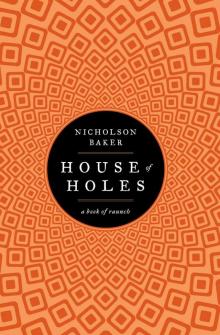 House of Holes
House of Holes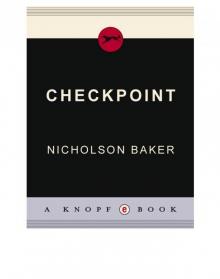 Checkpoint
Checkpoint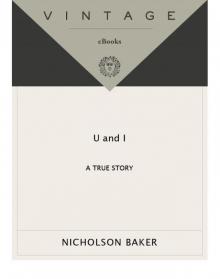 U and I
U and I The Fermata
The Fermata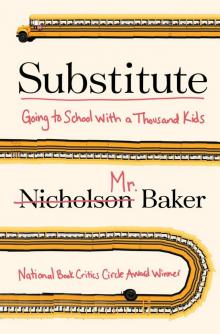 Substitute
Substitute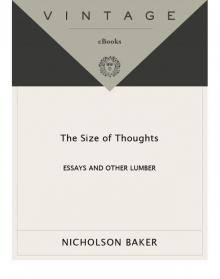 The Size of Thoughts
The Size of Thoughts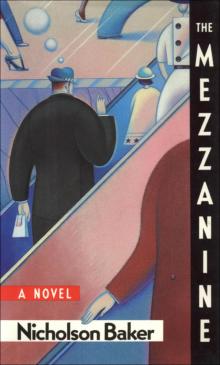 Mezzanine
Mezzanine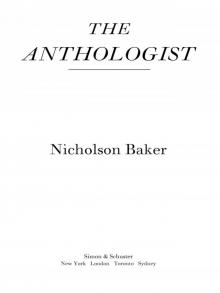 The Anthologist
The Anthologist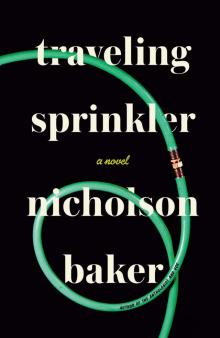 Traveling Sprinkler
Traveling Sprinkler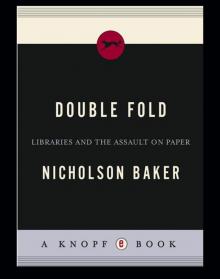 Double Fold
Double Fold The Everlasting Story of Nory
The Everlasting Story of Nory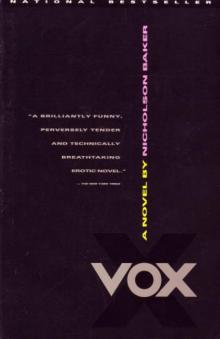 Vox
Vox Vintage Baker
Vintage Baker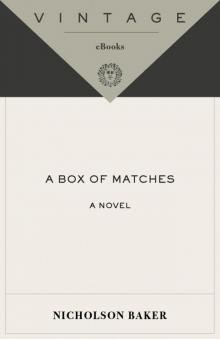 A Box of Matches
A Box of Matches